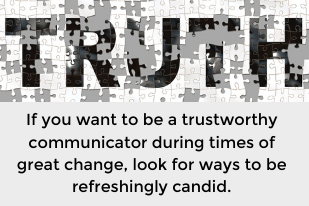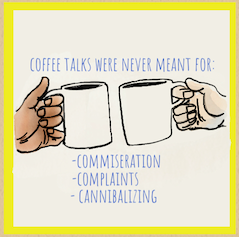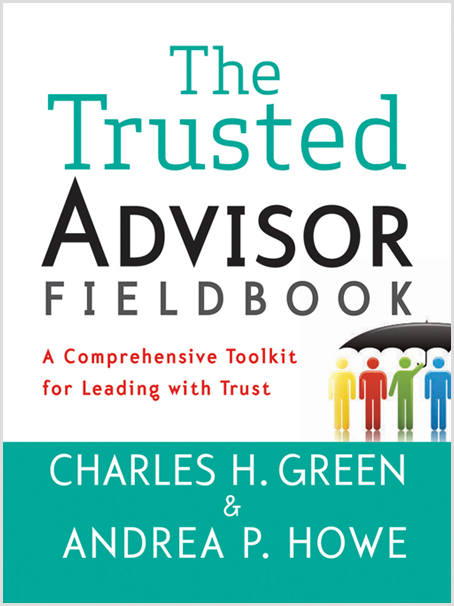This post is part of our Monthly-ish Tips series.

Last week, I shared five communication pitfalls that leaders are too often felled by during times of great change and uncertainty—specifically related to broadcasts (like presentations and staff-wide emails) as well as dialogue. I promised more trustworthy options this week, so here we are.
Here’s a brief recap of each of the five pitfalls—all of which usually arise out of the best of intentions—along with my recommended alternatives:
| Communication Pitfall | A More Trustworthy Alternative | |
|---|---|---|
 | 1. Commiseration—as in, “Oh yeah, I’m really pissed off about that too.” Commiseration isn’t (really) about connecting with or mirroring others; it comes across as you using their complaints as a springboard for indulging your own. | Empathize. Then empathize some more. Phrases like, “I can see how that would be frustrating” help you connect without making it all about you, and without acknowledging their feelings at the expense of the organization. |
 | 2. Invalidation—as in, “It’s not that bad. You should see how it went down during the last While you may be trying to lend perspective, negating someone’s complaint or point of view is actually worse than not listening. | Validate their point of view. A little affirmation that it’s OK/normal for people to feel the way they do goes a long way. Try saying things like, “Change is hard” (because, let’s face it, it is.) Just be sure you don’t immediately invalidate again with “but” or “however.” |
 | 3. Too much positivity too soon—as in, “ This one’s a close cousin to invalidation, only worse in some ways, because you’re trying to convert someone who’s worried/fearful/resistant/skeptical into an ally without first acknowledging their worries/fears/resistance/skepticism. | Acknowledge their negativity. The positive results of this unconventional approach can be explained by grasping the Sarick Effect. In a nutshell, meeting someone’s reserve with your optimism has the natural effect of raising their shields. Leading with their negativity, on the other hand (as in, “There are definitely downsides”) has the curious effect of being disarming and creating an ally rather than a confirmed foe. |
 | 4. Mr./Ms. Fix-It—as in, “Here’s what we can do to make it better!” There are three downsides of premature problem-solving when helping others deal with change: (a) you’re likely signing yourself up for unnecessary work, because often all they really needed is a sounding board, (b) if there is a problem to be solved, you’re probably solving the wrong one because you’re rushing to fix something rather than taking the time to get at the true, root issue, and (c) you’re missing opportunities to build intimacy along the way. | Get at the heart of the problem. Find out what’s at the source of the problem, first and foremost. “Tell me more” is a really useful and simple phrase to remember. Most likely there’s an emotion like fear or frustration behind the “problem,” so it’s extra helpful to combine empathy with your sensitive sleuthing. |
 | 5. “Blah blah blah”—as in, well, insert any kind of corporate-speak here. While consistency is important when we’re communicating about change, towing the party line in “blah blah blah” ways comes across as inauthentic and more about CYA (cover your you-know-what) than connection. | Use “human talk.” Shelve the party lines, jargon, and multi-syllabic words. Try speaking and writing in ways that are simple, straight forward, and acknowledging. Be refreshingly candid. You might even try a little self-deprecation or appropriate humor. |
None of the alternatives are effective, of course, if they aren’t delivered in a genuine way. Which points to another critical lesson for leaders at the tip of the change spear: Make your own self-care a priority during times of great change so you can be at your very best with the people you’re serving.
Custom illustrations courtesy of Wade Forbes of RedTale Communications.
Make It Real
This week, find an opportunity to apply at least one of the more trustworthy communication alternatives in your day-to-day interactions. Notice what kind of responses you get.
Learn More

Watch a short video on balancing blame and responsibility (Trust Tip #7), from our friends at Trusted Advisor Associates, or brush up on empathy tips in Chapter 6 of The Trusted Advisor Fieldbook.
Andrea Howe
Latest posts by Andrea Howe (see all)
- A lesson from my own trust “fail” in my first-ever client meeting - April 15, 2024
- Why choosing silence in the face of awkwardness can be a trust tragedy - March 21, 2024
- What NOT to do when you think you’re being ghosted - February 21, 2024
